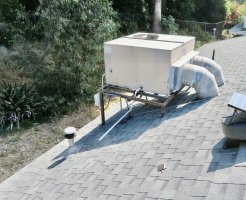jar546
CBO
I've encountered situations in the past where there was no violation, but under these changes, there certainly will be.
The 2023 National Electrical Code (NEC) has introduced important changes, specifically in Section 110.26(A)(6), which outlines new requirements for maintaining working spaces around electrical equipment. These changes emphasize the importance of safety and accessibility, ensuring that working areas around electrical installations are clear, level, and hazard-free.
Key Requirements:
Clear Working Space Violation:
The 2023 National Electrical Code (NEC) has introduced important changes, specifically in Section 110.26(A)(6), which outlines new requirements for maintaining working spaces around electrical equipment. These changes emphasize the importance of safety and accessibility, ensuring that working areas around electrical installations are clear, level, and hazard-free.
Code Breakdown: Section 110.26(A)(6)
Code Text: "The grade, floor, or platform in the required working space shall be kept clear, and the floor, grade, or platform in the working space shall be as level and flat as practical for the entire required depth and width of the working space."Key Requirements:
- Clear Working Space: The area designated as the working space around electrical equipment must be kept free from any obstructions. This means that no objects, tools, or equipment should encroach into this space.
- Level and Flat Surface: The floor, grade, or platform within the working space must be as level and flat as practical. This is essential for ensuring safety and ease of access to the electrical equipment.
TBCF Enhanced Content
The enhanced content provides practical scenarios where the new code section might be violated and the potential safety hazards these violations could introduce.Clear Working Space Violation:
- Example: A sump pump encroaching into the required width of the working space.
- Implication: Such an encroachment restricts the necessary clear space required for the safe operation and maintenance of electrical equipment. It could hinder access and create a tripping hazard, thereby increasing the risk of accidents.
- Example: Equipment installed on an uneven grade.
- Implication: If the ground where the equipment is installed is unlevel, servicing it can be unsafe and difficult. For instance, a generator transfer switch placed on a slope might be too high to reach safely without a ladder. Using a ladder on uneven ground further increases the risk of falls and injuries. This setup fails to provide a stable platform for maintenance activities, endangering the electrician.
Importance of Compliance
Adhering to Section 110.26(A)(6) is crucial for several reasons:- Safety: Clear, level and flat working spaces reduce the risk of accidents and injuries. Electricians need a stable and unobstructed area to perform their tasks efficiently and safely.
- Accessibility: Ensuring that the working space is free from obstructions and level allows for easier access to electrical equipment, facilitating regular maintenance and emergency interventions.
- Code Compliance: Failure to comply with the NEC can result in violations, potentially leading to fines, increased liability, and the need for costly rework to meet the code requirements.
Visual Aids
To better understand these violations, the enhanced content mentions exhibits showing practical examples:- Encroachment Violation: An exhibit displaying a sump pump intruding into the working space.
- Uneven Ground Violation: An exhibit showing electrical equipment installed on a sloped grade, highlighting the difficulty in safely servicing the equipment.

